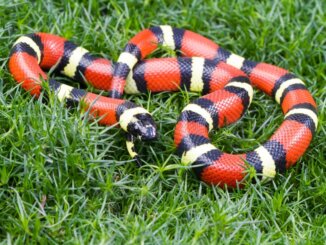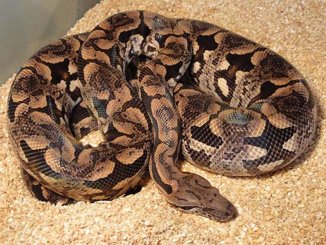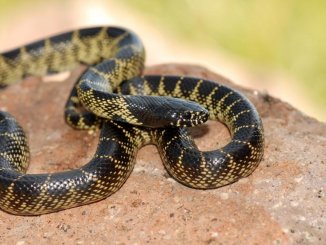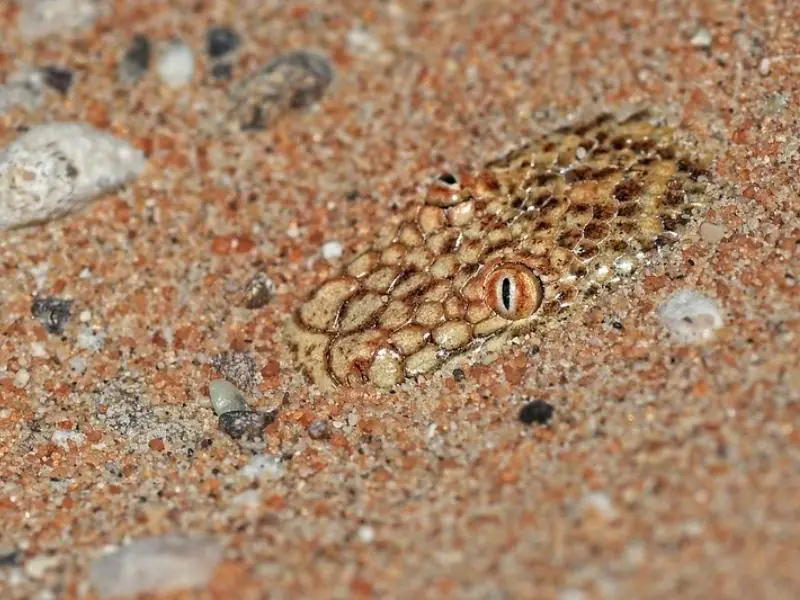
The Arabian sand boa is a small, nonvenomous snake hailing from the sandy deserts of the Arabian Peninsula and Iran.
Arabian sand boas are easy to care for and suitable for beginner snake-keepers due to their low care needs, simple enclosure setup, and hardiness.
Arabian Sand Boa Overview
| Common name | Arabian sand boa, Jayakar's sand boa |
| Scientific name | Eryx jayakari |
| Natural habitat | Natural habitat Sandy deserts in the Arabian Peninsula and Iran |
| Adult size | 13–15 inches |
| Average lifespan | 18–20 years |
| Diet | Carnivore |
| Housing | Minimum 15 gallons for one snake, 85–88°F air temperature, 30%–40% humidity |
| Experience | Beginner |
Origin
The Arabian sand boa originates in the Arabian Peninsula, including Oman, Yemen, Saudi Arabia, and Kuwait, and the Kerman, Bushehr, and Khuzestan Provinces of Iraq. The snake’s natural habitat is dry, warm desert land. Arabian sand boas spend their days burrowed underneath the sand, emerging at night to hunt for their prey.
Although Arabian sand boas are becoming increasingly rare in the wild, they’re listed by the IUCN as “Least Concern” since the snakes have a wide range and aren’t threatened in their habitat.
Appearance and Behavior
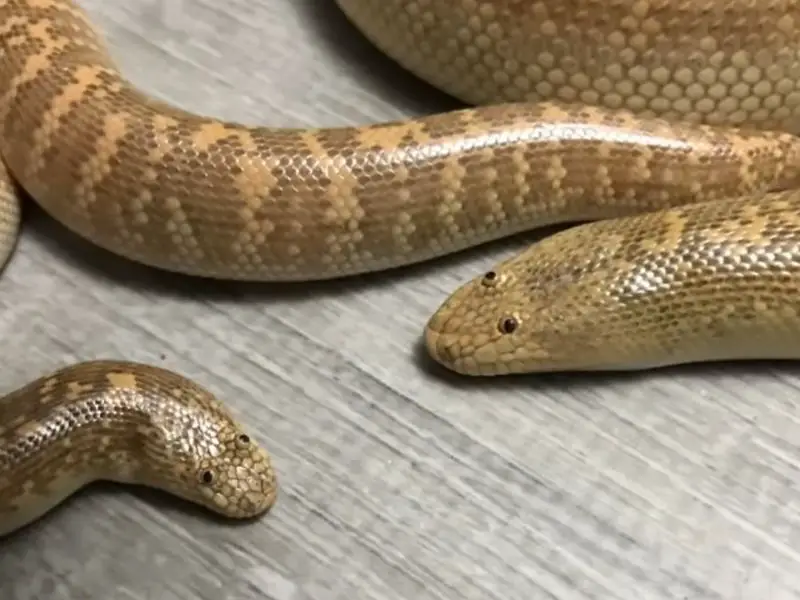
The Arabian sand boa has a yellowish, orange, or sandy brown speckled body, with a whitish belly. The snake’s eyes sit at the top of its head and are higher than the eyes of any other species of sand boa. This enables the snake to submerge its body and most of its head under the sand while hunting for prey.
Arabian sand boas are sexually dimorphic, meaning that telling the difference between males and females of this species is easy. Females are bigger and have shorter, blunter tails than males.
The Arabian sand boa’s head isn’t distinct from its body, giving it a noodle-like appearance. This appearance makes the snake highly adapted to burrowing in the sand.
Size and Lifespan
The Arabian sand boa is a small snake. Females grow to about 16 inches, and males reach about 14 inches when fully grown. The snakes weigh up to 0.4 pounds on average.
In captivity, Arabian sand boas live for 18–20 years with proper care. In the wild, the snakes have an average lifespan of 15 years.
Temperament
The Arabian sand boa is a slow-moving, docile snake that’s ideal for beginner snake-keepers. The snake is nocturnal and spends most of the day asleep. Arabian sand boas are solitary reptiles that prefer to be housed alone. Males are especially territorial and may fight if they’re housed together.
Arabian sand boas can be safely handled and are small enough to coil up on the palm of a person’s hand.
This snake species will only strike out if it feels threatened. Arabian sand boas strike sideways rather than straight-on.
Housing Arabian Sand Boas
The Arabian sand boa’s natural habitat is the hot, dry deserts of southern Iran and the Arabian Peninsula. The snake burrows under the sand to thermoregulate itself.
Provide a similar environment in captivity to ensure the snake is comfortable and happy in its new home. The ideal enclosure type for an Arabian sand boa is a glass or plastic terrarium with good ventilation.
Enclosure size
A single adult Arabian sand boa should be kept in a minimum 15-gallon tank, ideally 20 gallons. The enclosure should be wider than it is tall to allow the snake to traverse beneath the sand in tunnels.
The enclosure length should be longer than the snake, about 20 inches. Width and height of 10 inches are suitable.
Lighting
The Arabian sand boa is nocturnal, but the snake still needs a full-spectrum day and night cycle. Ensure the tank is placed in a room that receives around 10 hours of natural daylight per day.
UVB lighting isn’t essential for this snake species, but some people choose to install a UVB bulb above the enclosure for the potential benefits of UVB.
Dedicated LED lighting isn’t necessary unless the tank is located in a dark room or your enclosure contains lots of live plants.
Temperature and Humidity
The ideal temperature range for an Arabian sand boa’s enclosure is 85–88°F. Install an under-tank heater with a thermostat to maintain these temperatures.
During the day, the enclosure temperature can rise to 90°F. Overnight, allow the temperature to dip to 70°F.
Provide a temperature gradient — a warm section and a cooler section — by locating the heater at one end of the tank, so it heats up one-third of the enclosure. This will allow the snake to regulate its temperature by moving between the different sections.
The enclosure’s humidity should be around 40%. Don’t allow humidity to drop below 30% or climb higher than 50%.
Maintain low-humidity conditions by properly ventilating the enclosure and placing the water bowl in the cool end of the tank.
You can assist with shedding by providing your snake with a humid hide, made with damp paper towels and moss, for your snake to retreat to.
Substrate and Decoration
Arabian sand boas are most commonly found in sandy deserts, but they also live in soils. The best types of substrate for an Arabian sand boa enclosure are fine sand, shredded newspaper, and aspen chips. For a natural look, mix 1/4 sand with 3/4 topsoil. Make sure the substrate is deep enough for the snake to burrow in.
Don’t use cedar chips, Savannah chips, or gravel for an Arabian sand boa tank. These substrates are irritating to the snake or difficult to burrow in.
Use live plants or artificial foliage to give the enclosure an aesthetically pleasing appearance. Silk plants are ideal for an Arabian sand boa tank. Logs, rocks, and large bark pieces are other good decorations for the tank, providing shelter and climbing opportunities.
Stagnant air is bad for an Arabian sand boa’s respiratory health, so make sure the enclosure is well-ventilated with a screen top or small fans that circulate the air. This snake species is strong and smart, so use a lockable sliding lid to prevent the snake from escaping into your house.
Cleaning
To prevent bacteria buildup, deep clean the enclosure at least once every two months. Transfer the snake to a temporary enclosure and remove the decorations and substrate. Wipe down the plants and rocks with a cloth dipped in warm water.
Use a snake-friendly enclosure cleaner or warm water mixed with vinegar to clean the tank’s walls and floor. Once the enclosure and decorations are completely dry, add a fresh layer of substrate, return the decorations, and transfer the snake back into the tank.
To reduce your work during deep cleaning, spot-clean the enclosure once a day. Remove leftover food, shed skin, and waste, and wash out and replenish the snake’s water bowl.
Arabian Sand Boa Care
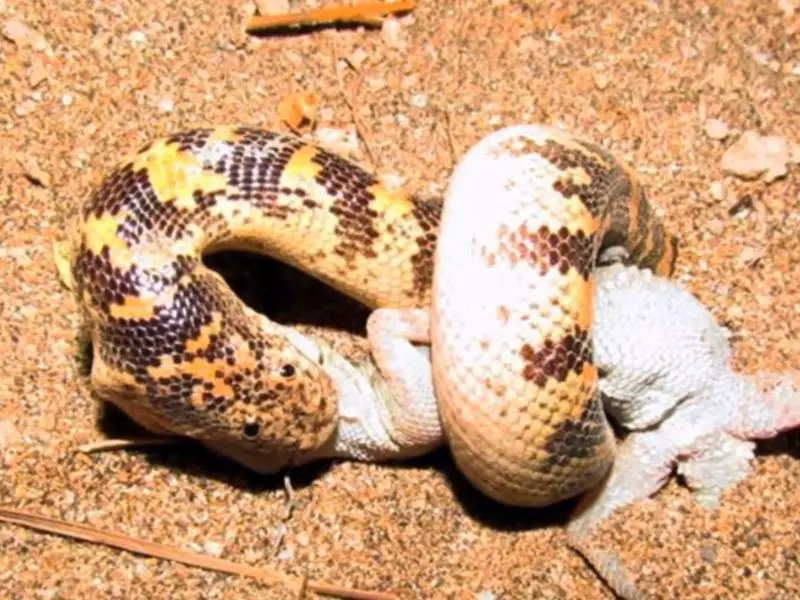
Arabian sand boas are small, docile snakes, making them a good choice for beginner snake-keepers. They’re easy to feed and aren’t disease-prone.
Food and Water
In the wild, the Arabian sand boa eats virtually any food it can catch, including birds, rodents, and lizards. The snakes should be fed a carnivorous, protein-rich diet in captivity, but varying the diet isn’t essential. Many snake-keepers feed their boas a diet of frozen and thawed mice, which provides all the nutrients the snakes need.
Feed juvenile Arabian sand boas one prey item, such as a small pinkie mouse, every seven days. Adult snakes should be fed a medium-sized mouse every 10 to 14 days. Juveniles need more frequent feeding than adults to support their growth into adults.
Don’t feed your snake live prey. The prey is likely to transmit parasites into the enclosure and may injure the snake during feeding. Instead, use a pair of long tongs to lower the thawed prey into the enclosure and wiggle the tongs to encourage the snake to strike. Feed the snake in the evening, when it would usually hunt in the wild.
Arabian sand boas don’t drink a lot, but you should still provide the snakes with constant access to water. Place a heavy-bottomed water bowl, big enough for the snake to get into but not so deep that the snake can’t easily get out, on the floor of the enclosure. Make sure the water bowl is non-porous to prevent a spike in humidity.
Handling
Arabian sand boas tolerate handling well. Just make sure to handle the snake with care to prevent startling or stressing your pet. Support the snake’s full weight in your hands, but don’t grasp its body — this could cause injuries. Wash and sanitize your hands before handling your snake, and never handle the snake 24 hours before or 48 hours after feeding.
Handle your sand boa gently and often — for at least one hour once a week — to get it used to your presence.
Common Health Issues
The Arabian sand boa is a healthy, hardy snake, but there are several health conditions and other problems that the snake may experience due to poor care.
Obesity
Arabian sand boas have big appetites and will eat any food offered to them. Beginner snake-keepers often overestimate how much food their snakes require. The snakes are prone to obesity, which increases the risk of heart and liver failure if they’re consistently overfed. Prevent obesity by sticking to a consistent feeding schedule.
Dermal Abrasion
Using rough substrates in your enclosure may damage your Arabian sand boa’s skin when the snake burrows underground. Prevent dermal abrasion by avoiding harsh, rough substrates, such as those made from gravel. Arrange an appointment with your veterinarian if you’re concerned about a possible injury to your snake’s skin.
Scale Rot, Mouth Rot, and Respiratory Infections
Incorrect care or poor enclosure conditions may cause scale rot, mouth rot, or respiratory infections in your snake. Incorrect substrates and high humidity may encourage bacterial growth, which causes numerous diseases in your snake. Prevent respiratory issues and scale and mouth rot by ensuring the humidity, substrate, and temperature in the enclosure are correct, and by cleaning the enclosure regularly.
Breeding
Breeding Arabian sand boas in captivity are easy. The snakes become sexually mature at 18 inches long (females) or 12 inches long (males).
To breed two Arabian sand boas, follow these steps:
- Select a healthy male and female sand boa. Keep the snakes in separate enclosures for now
- Prepare the snakes for breeding by reducing the enclosure temperature to 70°F and changing the light cycle to 10 hours of daylight and 14 hours of darkness. Continue to feed the snakes as normal
- After three months of “winter”, place the snakes in the same enclosure in the evening. Leave the snakes in the enclosure for one week, then remove the male to feed both snakes separately
- Return the male after feeding. Continue the process until you notice a bump in the female’s belly, indicating that she’s gravid (pregnant)
- Remove the male and place the female in a nesting box that’s large enough for her to move around in
- After the female gives birth, incubate the eggs at 91°F for 66 days, until the eggs hatch
- Place the hatched babies in their own separate 5-gallon enclosures
- Once the babies have had their first shed, they can be fed their first pinkie mouse
Choosing and Buying an Arabian Sand Boa
The average cost of an Arabian sand boa is $200–$1,000, depending on the snake’s age and gender, and the seller’s reputation.
Arabian sand boas are largely unavailable in the pet trade, so breeders can afford to charge more for their snakes, knowing that people will pay for them.
When shopping for an Arabian sand boa, make sure your chosen snake has clear, alert eyes, healthy eating habits, and smooth, shiny scales. Avoid snakes with skin abrasions or swelling, mucus around the eyes and nose, lethargic behavior, or any other signs of poor health. Captive-bred snakes are generally healthier and tamer than wild-caught snakes.

